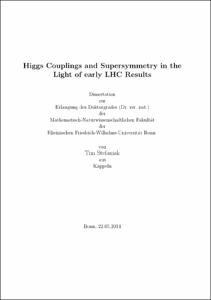Stefaniak, Tim: Higgs Couplings and Supersymmetry in the Light of early LHC Results. - Bonn, 2014. - Dissertation, Rheinische Friedrich-Wilhelms-Universität Bonn.
Online-Ausgabe in bonndoc: https://nbn-resolving.org/urn:nbn:de:hbz:5n-36975
Online-Ausgabe in bonndoc: https://nbn-resolving.org/urn:nbn:de:hbz:5n-36975
@phdthesis{handle:20.500.11811/6140,
urn: https://nbn-resolving.org/urn:nbn:de:hbz:5n-36975,
author = {{Tim Stefaniak}},
title = {Higgs Couplings and Supersymmetry in the Light of early LHC Results},
school = {Rheinische Friedrich-Wilhelms-Universität Bonn},
year = 2014,
month = aug,
note = {We present phenomenological studies investigating the implications of early results from the Large Hadron Collider (LHC) for models beyond the Standard Model (BSM), mostly focusing on Supersymmetry (SUSY). Our work covers different aspects in this wide field of research. We describe the development and basic concepts of the public computer codes HiggsBounds (version 4) and HiggsSignals. These confront the Higgs sector predictions of BSM models with results from LEP, Tevatron and LHC Higgs searches. While HiggsBounds tests the model against experimental null-results, HiggsSignals evaluates the model’s chi-squared compatibility with the signal rate and mass measurements of the Higgs boson, that was discovered by the LHC in 2012. We then perform a systematic study of potential deviations in the Higgs couplings from their Standard Model (SM) prediction. No significant deviations are found. Future capabilities of Higgs coupling determination at the later LHC stages and at the International Linear Collider (ILC) are explored. We also study the implications of the Higgs discovery for the Minimal Supersymmetric Standard Model (MSSM), considering either the light or the heavy CP-even Higgs boson as the discovered state. We show that both interpretations are viable and discuss their phenomenology. Finally, we study the LHC signatures of resonant scalar lepton production, which may arise in SUSY models with R-parity violation (RPV). These are confronted with early LHC results, yielding constraints on the relevant RPV operators.},
url = {https://hdl.handle.net/20.500.11811/6140}
}
urn: https://nbn-resolving.org/urn:nbn:de:hbz:5n-36975,
author = {{Tim Stefaniak}},
title = {Higgs Couplings and Supersymmetry in the Light of early LHC Results},
school = {Rheinische Friedrich-Wilhelms-Universität Bonn},
year = 2014,
month = aug,
note = {We present phenomenological studies investigating the implications of early results from the Large Hadron Collider (LHC) for models beyond the Standard Model (BSM), mostly focusing on Supersymmetry (SUSY). Our work covers different aspects in this wide field of research. We describe the development and basic concepts of the public computer codes HiggsBounds (version 4) and HiggsSignals. These confront the Higgs sector predictions of BSM models with results from LEP, Tevatron and LHC Higgs searches. While HiggsBounds tests the model against experimental null-results, HiggsSignals evaluates the model’s chi-squared compatibility with the signal rate and mass measurements of the Higgs boson, that was discovered by the LHC in 2012. We then perform a systematic study of potential deviations in the Higgs couplings from their Standard Model (SM) prediction. No significant deviations are found. Future capabilities of Higgs coupling determination at the later LHC stages and at the International Linear Collider (ILC) are explored. We also study the implications of the Higgs discovery for the Minimal Supersymmetric Standard Model (MSSM), considering either the light or the heavy CP-even Higgs boson as the discovered state. We show that both interpretations are viable and discuss their phenomenology. Finally, we study the LHC signatures of resonant scalar lepton production, which may arise in SUSY models with R-parity violation (RPV). These are confronted with early LHC results, yielding constraints on the relevant RPV operators.},
url = {https://hdl.handle.net/20.500.11811/6140}
}






